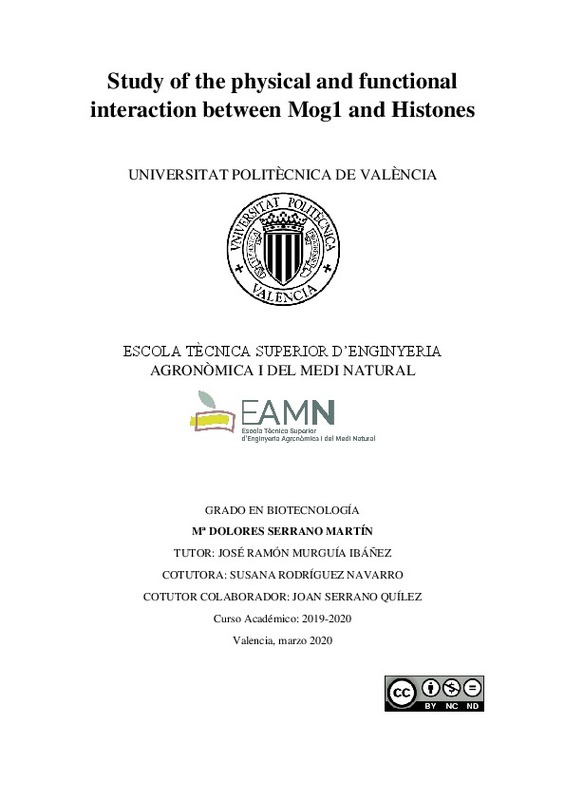|
Resumen:
|
[EN] Mog1 was first described as a Gsp1-binding protein involved in nuclear protein import both in humans and yeast, being Gsp1 the homologue of the human Ran-GTPase. Later, it was found that human Mog1 also regulates the ...[+]
[EN] Mog1 was first described as a Gsp1-binding protein involved in nuclear protein import both in humans and yeast, being Gsp1 the homologue of the human Ran-GTPase. Later, it was found that human Mog1 also regulates the traffic of Nav1.5, the ¿-subunit of the cardiac sodium channel, that has been associated with Brugada syndrome, a cardiac disease. Recently, it has been discovered that Mog1 regulates mRNA transcription and export to the cytoplasm in Saccharomyces cerevisiae by participating in the establishment of epigenetic marks during transcription, specifically H2B monoubiquitylation on lysine 123 (H2Bub1) and H3 trimethylation on lysine 4 (H3K4me3). These post-translational modifications (PTMs) are correlated with actively transcribed genes, being important for transcription elongation, amongst other functions. In addition, there is a crosstalk between H2Bub1 and H3K4me3 since H2Bub1 has been shown to stimulate H3K4me3. However, the exactly molecular mechanism explaining why these PTMs enhance transcription is not fully understood, although some mechanisms have been proposed in which several proteins and complexes are involved.
How Mog1 participate in this process is unknown but it was proposed that it is independent on its role in Gsp1 binding, suggesting the existence of two cellular pools of Mog1 protein. Moreover, it has been shown that two subunits of the COMPASS complex, Shg1 and Sdc1, and histones H2B1, H3 and H4, amongst other proteins, co-precipitate with Mog1-Tap tagged. The interaction between Shg1 and Mog1 has been validated through a genome wide Shg1 two-hybrid screening, finding a region in Mog1 between amino acids residues 114 and 154 as the putative binding domain. Part of this region is located in a long loop connecting two beta sheets where there is a tryptophan residue at position 145 especially exposed. Therefore, it is interesting to study if this loop and, especially, W145 are important for Mog1-Shg1 binding.
On the other hand, Mog1 co-immunoprecipitation with histones H2B1, H3 and H4 revealed that Mog1 could participate in the establishment of H2Bub1 and H3K4me3 by directly or indirectly binding histones. Of especial interest is H2B because of H3-K4 trimethylation dependency on H2B-K123 monoubiquitylation. Consequently, it is important to clarify if Mog1 interacts with H2B directly and if so, to determine the interaction domain.
Furthermore, it was found in a screening that lysine at position 189 in Mog1 can be ubiquitylated which points Mog1 as a putative substrate for posttranslational modifications.
Therefore, the main objective of this study is to gain knowledge about the role of Mog1 in the modulation of histone epigenetic modifications H2Bub1 and H3K4me3 by, on the one hand, analysing the phenotypic effect of several Mog1 mutants and, on the other hand, characterising histone H2B-Mog1 interaction.
[-]
[ÈS] Mog1 fue descrita por primera vez como una proteína de unión a Gsp1, proteína homóloga a Ran- GTPasa en humanos, que participa en la importación de proteínas al núcleo tanto en levadura como en humanos. Más tarde, se ...[+]
[ÈS] Mog1 fue descrita por primera vez como una proteína de unión a Gsp1, proteína homóloga a Ran- GTPasa en humanos, que participa en la importación de proteínas al núcleo tanto en levadura como en humanos. Más tarde, se encontró que, en humanos, Mog1 regula el tráfico de Nav1.5, la subunidad α del canal de sodio cardiaco, que ha sido asociada con el síndrome de Brugada, una enfermedad cardiaca. Recientemente, se ha descubierto que Mog1 también regula la transcripción y exportación del ARNm en Saccharomyces cerevisiae mediante la participación en el establecimiento de marcas epigenéticas durante la transcripción. Estas modificaciones postraduccionales (PTMs por sus siglas en inglés) son la monoubiquitinación de H2B en la lisina 123 o H2Bub1 y la trimetilación de la histona H3 en la lisina 4 o H3K4me3 que están relacionadas con genes activamente transcritos y son importantes en la elongación transcripcional, entre otras funciones. Además, existe una intercomunicación entre H2Bub1 y H3K4me3 ya que se ha demostrado que H2Bub1 estimula la trimetilación de H3 en K4. Sin embrago, no se ha caracterizado todavía un mecanismo molecular que explique por qué estas PTMS aumentan la transcripción, aunque varios mecanismos se han propuesto englobando varias proteínas y complejos.
Se desconoce cómo Mog1 participa en este proceso, pero se ha propuesto que esta función es independiente a su unión a Gsp1, sugiriendo la existencia de dos pools celulares de Mog1. Además, se ha encontrado que dos subunidades del complejo COMPASS, Shg1 y Sdc1, y las histonas H2B1, H3 y H4, entre otras proteínas, coprecipitan en un ensayo con Mog1 con cola Tap. La interacción entre Mog1 y Shg1 ha sido validada en un ensayo de doble híbrido empleando Shg1 como la proteína bait, en el que además se describió una región en Mog1 entre los aminoácidos 114 y 154 como posible dominio de interacción. Parte de esta secuencia está localizada en una región de bucle que conecta dos láminas beta y que contiene un triptófano en posición 145 con su cadena lateral especialmente expuesta. Por lo tanto, es interesante estudiar si esta región de bucle y, en concreto, W145 son importante para la interacción entre Mog1 y Shg1.
Por otra parte, la co-inmunoprecipitación de Mog1 e histonas H2B1, H3 y H4 sugiere que Mog1 podría desempeñar su función en el establecimiento de H2Bub1 y H3K4me3 interaccionando directa o indirectamente con las histonas. H2B es de especial interés por su influencia en la trimetilación de H3 en K4. Por ello, es importante estudiar si Mog1 interacciona con H2B directamente y en tal caso, determinar el dominio de interacción.
Además, un estudio ha encontrado que la lisina 189 en Mog1 puede estar ubiquitinada, indicando que Mog1 también puede ser sustrato para las modificaciones postraduccionales.
En consecuencia, el objetivo principal del presente estudio es indagar en la implicación de Mog1 en el establecimiento de las marcas epigenéticas H2Bub1 y H3K4me3 mediante el análisis del efecto fenotípico de varias mutaciones en la proteína Mog1, y la caracterización de la interacción entre la histona H2B y Mog1.
[-]
|








